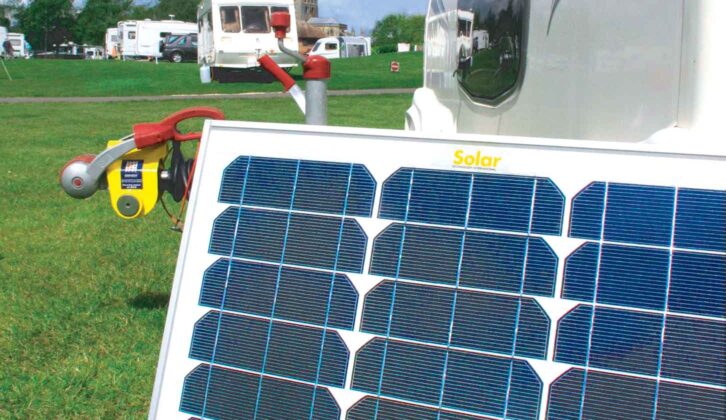Caravanners, like all lovers of the great outdoors, are keen to live cleaner and greener, to protect the environment for our children… and yours. One way to do this, and make free electricity for a decade or more, is with a caravan solar panel.
Although there is an initial investment of natural resources (in the manufacturing) and money (in the purchasing), once you have gone through the process of installing a caravan solar panel, a modern solar array will silently produce free power, day after day, year after year.
They will require barely any maintenance, too, bar a regular clean to keep their performance at optimal levels, and they can be especially helpful for those who like to go off-grid in a caravan.
How do caravan solar panels work?
Basically, modern photovoltaic (PV) solar panels convert sunlight into usable electrical energy to keep the best caravan leisure battery charged up, which in turn can power 12V appliances. The system is typically made up of one or more solar panels permanently mounted on the van roof, or as portable units set up beside the caravan.
These PV panels are made from silicon cells. The cells absorb sunlight, which excites electrons within the material. This movement of electrons generates an electrical (DC) direct current, which can be used to charge your battery.

The electricity generated by the panels is not fed directly into your battery; first it passes through a charge controller, also known as a regulator.
The charge controller is really crucial, because it manages the flow of electricity, preventing the battery from being overcharged or damaged. It ensures safe, efficient charging.
Maximum Power Point Tracking (MPPT) controllers optimise charging in varying light conditions. From the charge controller, the regulated DC power flows into your van’s leisure battery, keeping it topped up even when the caravan is not actually in use.

The battery stores this energy, making it available for use at any time, day or night. The stored energy can then power lights, water pumps, phone chargers, the best caravan TVs, and other low-voltage devices in the caravan.
In this way, PV solar systems offer free, reliable, renewable energy for off-grid and eco-conscious caravan adventures.
The benefits of PV solar panels
1 Off-grid capability
One of the primary benefits of fitting PV solar panels to a caravan is the ability to go off-grid. With a solar set-up, you can pitch at remote locations without the need for electric hook-up. Whether you’re wild camping or staying at a basic CL, you’ll still have access to lighting, charging points, water pumps and even some low-power appliances.
This freedom opens up a whole new world of travel opportunities, releasing you from the restrictions of campsites that provide full facilities.
2 Charging your leisure battery
Solar panels are an effective way to keep your leisure battery topped up, particularly during spring and summer when daylight is abundant.
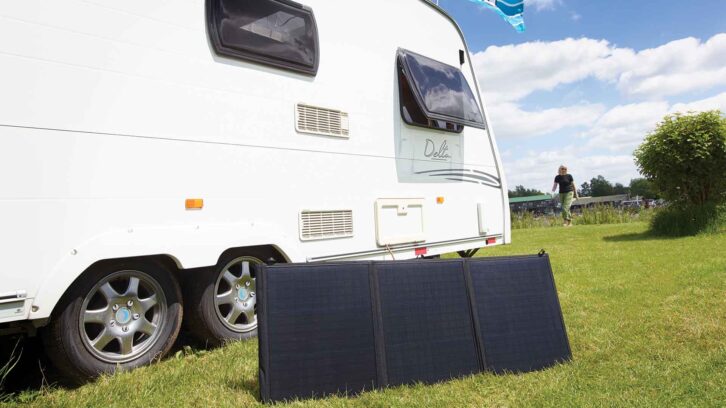
A sizeable panel and charge controller can also maintain the battery’s health over time, reducing the likelihood of deep discharge, therefore prolonging battery life. Even when you are storing your caravan, a solar panel can trickle-charge the battery, ensuring it remains in good condition between trips.
3 Security and peace of mind
If you’re after a way to improve your caravan security, a solar panel can help. In fact, solar power can play a vital part in keeping your caravan’s alarm and tracker systems operational, especially when the vehicle is being left unattended for longer periods. In storage, these security devices are powered by the leisure battery, so a flat battery could disable them, making your van more vulnerable, and possibly invalidating your insurance.
A solar panel offers a low-maintenance and automated way to keep your battery continuously charged. Even short winter days ought to provide enough charge to keep an efficient security system functioning as it should.
4 Environmental benefits
Opting for a solar panel on a caravan really is a win for the planet. By harnessing the sun’s rays, you dramatically cut down your reliance on both fossil fuels and mains hook-up. Yes, there’s an environmental footprint to manufacture the panels themselves, but once they’re in place, you’re generating silent, clean energy for years – often decades – without so much as a whiff of emissions.
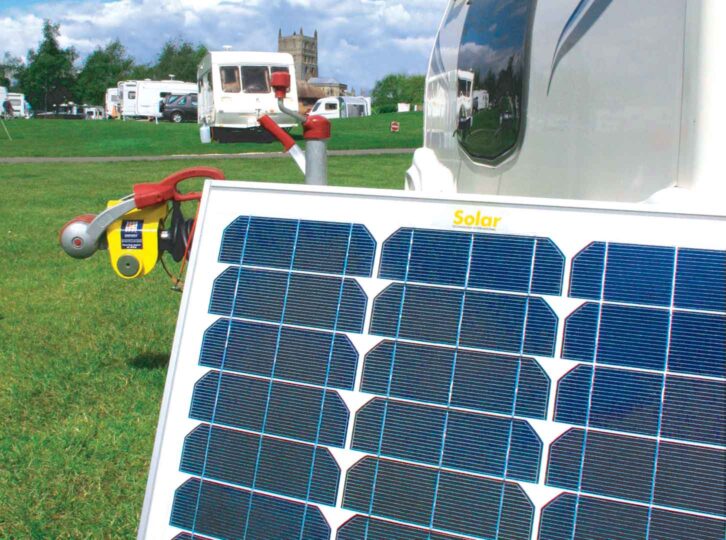
For any caravanner who cares about their impact on the countryside they love to explore, that’s a pretty persuasive argument for going solar.
5 Long-term financial savings
Although there’s an upfront cost, over time a solar panel can save money. You’ll be less reliant on paid hook-ups, and your leisure battery may last longer if it’s consistently well maintained. For frequent users, savings can quickly add up, making solar a sound investment.
The cons of PV solar panels
1 The cost
A decent quality panel, controller, cables and installation can cost several hundred pounds. Although prices have come down in recent years, this is still a significant outlay for many.
2 The weather
As you’d expect, the weather plays a big part in how effective your solar set- up will be. For those who like winter caravanning or find themselves touring during extended cloudy periods, energy production drops significantly. While solar panels still work in overcast conditions, the output is much lower, which could lead to undercharging or even a flat battery if you rely on them too heavily.
3 Space
Caravans have limited roof space (unless you’re looking at cleaning a caravan roof at which point it can seem quite big!), so you may have trouble fitting a sizeable panel in among the rooflights and vents.
4 Potential for theft or vandalism
Solar panels may attract unwanted attention. Portable or semi-portable panels can be particularly vulnerable to opportunist theft if left unattended.
5 Maintenance and upkeep
Solar panels are low-maintenance, but they aren’t maintenance-free. Panels can get dirty, especially if the caravan is being stored under trees. Occasional cleaning is required to maintain performance.
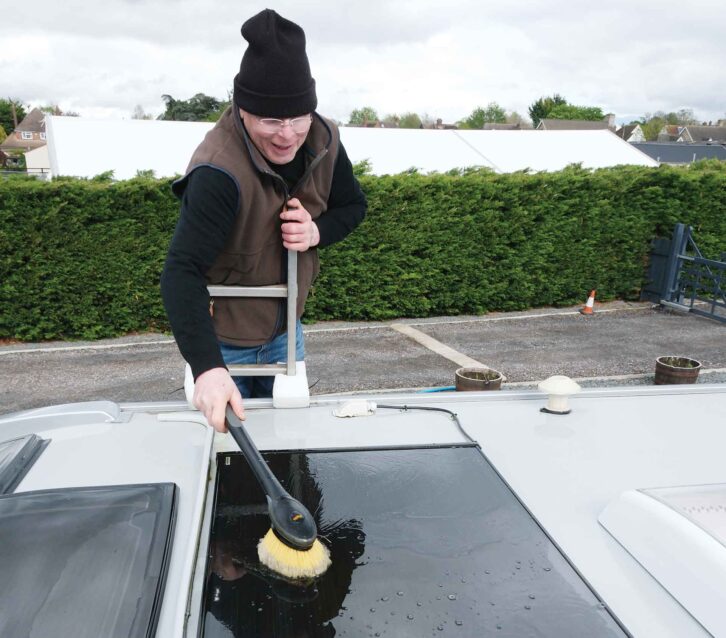
What to look for when buying solar panels for your caravan
Choosing the right solar panel system is absolutely essential to ensure it suits your energy needs, budget and available space on your caravan. Here are the key factors that you should consider before making your purchase.
Power output
First things first. What size solar panel do you need for a caravan?
Solar power output is measured in watts (W). This indicates how much electricity the panel can produce under ideal conditions. For caravanning purposes, panel sizes typically range from 50W to 200W. As a general rule:
- 50W to 80W is suitable for basic needs like LED lighting and phone charging.
- 100W to 150W can power small appliances and keep your leisure battery healthy during short trips.

- 150W to 200W+ is ideal for regular off-grid use, powering laptops, TVs, water pumps, and more. Consider how much power you’ll realistically need. If you are running multiple devices or you regularly stay off-grid, a higher-output system is going to offer better performance and leisure battery maintenance.
Panel type
There are two main types of solar panel: monocrystalline and polycrystalline, both made using different forms of silicon.
Monocrystalline panels use high-purity silicon and are generally more efficient, particularly in lower light conditions. They also tend to be smaller for the same power rating, making them ideal for caravans where space is relatively limited.
Polycrystalline panels are slightly less efficient, and larger for the same output. However, as they often have a lower price point, they’re still a viable option, especially if budget is a priority… and roof space isn’t.
Rigid vs flexible panels
Design and application matter just as much as output. Caravan solar panels come in both rigid and flexible versions:
Rigid solar panels have an aluminium frame and a protective glass top. They are durable, long-lasting and efficient, and are typically mounted permanently to the roof of the caravan. But it should be noted that they can be heavy and more visible.
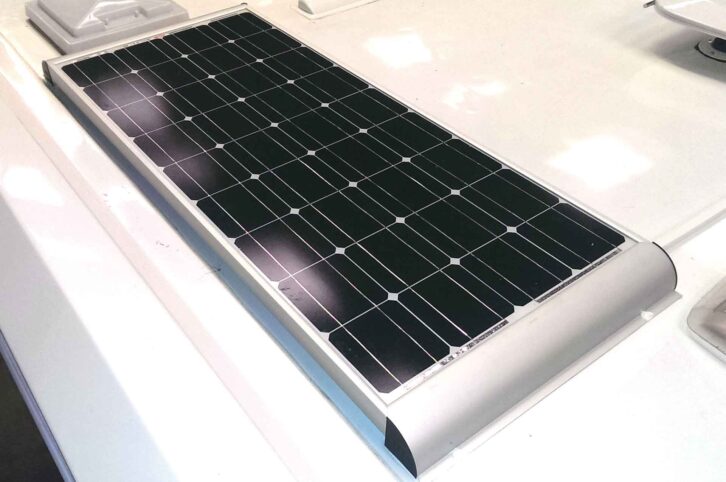
Flexible panels are lighter and slimmer, and can contour to the shape of your roof. They’re more discreet and easier to install with adhesive. The best, modern flexi-panels can be walked on.
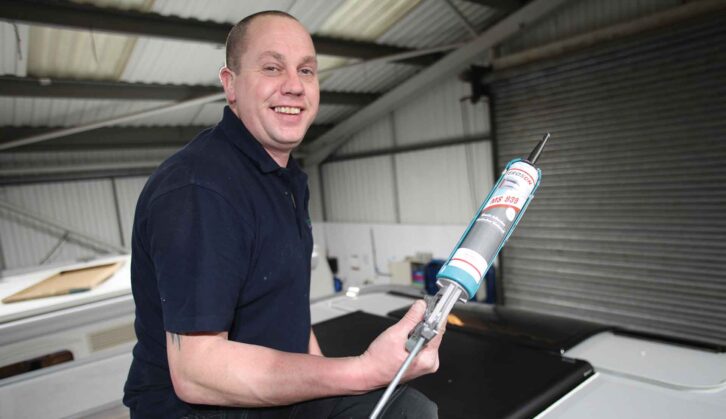
Size and available space
Before you choose a solar panel for your caravan, measure the available roof space, allowing for vents and aerials, and so on, before committing to a panel.
If roof space is tight, you may need to go for a higher-efficiency panel to obtain more power from a smaller footprint.

Alternatively, you might consider portable or suitcase-style panels, which can be placed on the ground when needed and stowed away when not in use.
Mounting and placement
Solar panel placement affects performance. Ideally, panels should be mounted in a way that maximises sun exposure – typically facing upwards and not shaded by roof features (AC units or satellite dishes). On site, position your van away from surrounding trees or buildings.
Permanent roof mounting is very convenient, but won’t allow you to maximise the charging potential by pointing the panels directly at the sun.
Portable panels offer better flexibility in this respect, if you can be bothered to move them around during the day. Facing them east before you turn in for the night means you’ll be charging your leisure battery from first light. In summer, this can add three or four hours of extra charge time.
Regulator (charge controller) compatibility
Don’t overlook the importance of a quality charge controller, which manages the flow of power from the solar panel to your leisure battery.
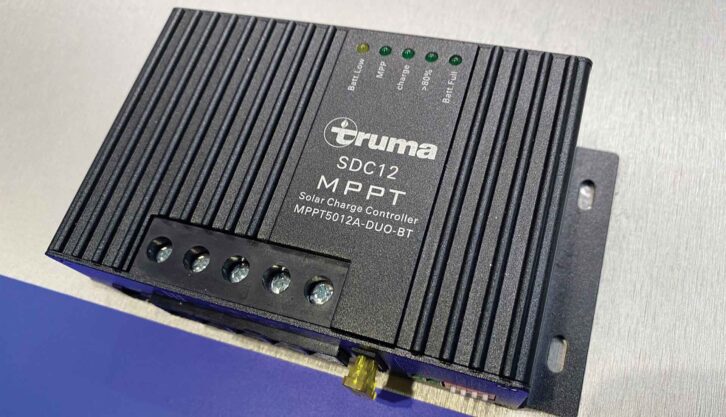
If your budget allows, look for MPPT controllers, which are more efficient than Pulse Width Modulation (PWM) alternatives, especially if the solar panels are being used in variable light conditions.
Make sure the controller is rated for the panel’s output and battery type (lead-acid, AGM, lithium, and so on – take a look at our guide to “Are lithium leisure batteries worth it?” if you’re undecided on the type to opt for). Your retailer should be able to advise.
Build quality, warranty
Finally, pay attention to build quality, waterproof ratings and the system’s warranty. A panel intended for outdoor use should be rated IP65, UV-resistant and solidly constructed.
Reputable manufacturers often offer warranties of 10 years plus, providing peace of mind.
You should buy from a reputable dealer (such as one at an NEC show) for the best products, prices and after-sales service. Buying cheap online may well be a false economy.
Another power source you can consider for a tour is a power bank – see what I have to say about a portable power station for a caravan.
Future Publishing Limited, the publisher of Practical Caravan, provides the information in this article in good faith and makes no representation as to its completeness or accuracy. Individuals carrying out the instructions do so at their own risk and must exercise their independent judgement in determining the appropriateness of the advice to their circumstances and skill level. Individuals should take appropriate safety precautions and be aware of the risk of electrocution when dealing with electrical products. To the fullest extent permitted by law, neither Future nor its employees or agents shall have any liability in connection with the use of this information. You should check that any van warranty will not be affected before proceeding with DIY projects.
If you’ve enjoyed reading this article, why not get the latest news, reviews and features delivered direct to your door or inbox every month. Take advantage of our brilliant Practical Caravan magazine SUBSCRIBERS’ OFFER and SIGN UP TO OUR NEWSLETTER for regular weekly updates on all things caravan related.
